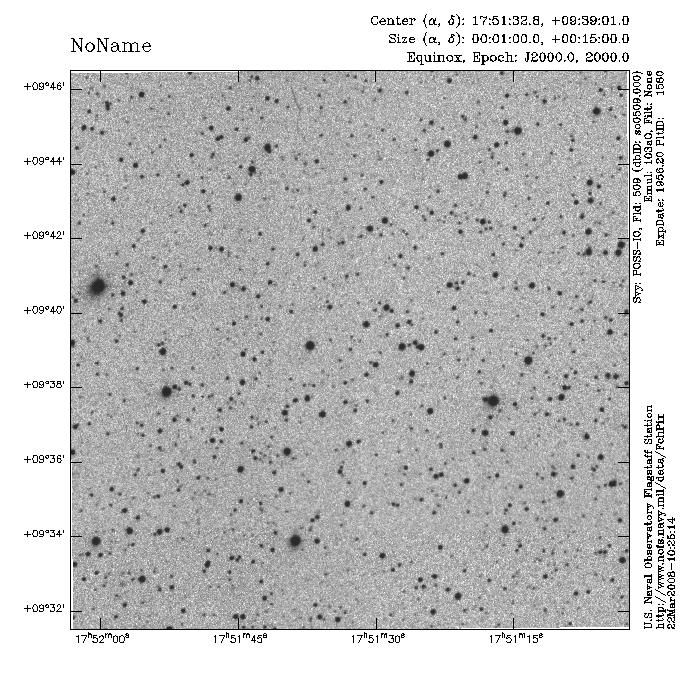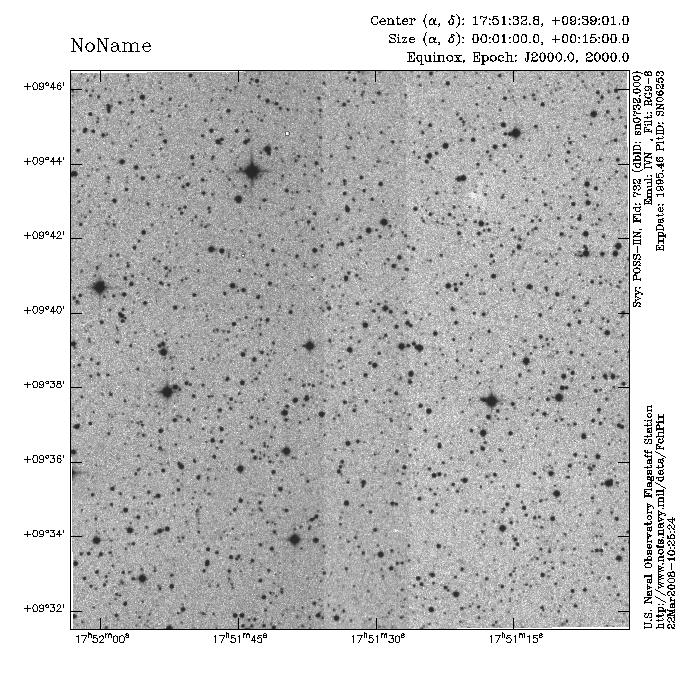Home Page Updated on April 1, 2008
MisV1439: Discovery of Another Optically Violently Variable Quasar 4C 09.57
2008 Mar. 23 We discovered a quasar 4C 09.57 is an optically violently variable quasar in the course of the MISAO Project. 
This is our second optically violently variable quasar discovery, after QSO B0133+47 discovered on 2008 Feb. 8. However, we do not know whether the variation of this quasar was already known or not. The variation of this quasar was discovered by Seiichi Yoshida (MISAO Project) in the MISAO Project variable star survey. It was picked up as one of the new variable star candidates from Youichirou Nakashima (Okayama, Japan)'s unfiltered CCD images on 2007 July 30 and 2008 Mar. 20 by the PIXY System 2. It was bright as 14.4 mag on 2007 July 30, but not visible on 2008 Mar. 20 (fainter than 15.3 mag). Yoshida checked Nakashima's CCD images on 2007 May 31 and found it was bright as 14.1 mag. Ken-ichi Kadota observed it on 2008 Mar. 22, and confirmed that now it is so faint as 18.1 mag. Therefore, we discovered the variation of this quasar is at least 4 mag. Here are the data of this quasar: USNO-A2.0 0975.09850990 17h51m32s.817 +09o39'00".61 Mag(R):17.0 Mag(B):17.9 4C 09.57 BLL 17 51 32.8186 +09 39 00.728 17.83B OT 081 17h51m32s.8 +09o39'02" 16.78 mag(V) B-V:0.68 U-B:-0.47 -24.1 mag(abs) z=0.320 1AXG J175132+0939 17h51m32s.66 +09o39'03".9 Value(ct/ks):77.6 Hard:-0.08 LEDA 84878 17h51m32s.8 +09o39'00" We the MISAO Project registered it as the 1439th new variable star, and assigned the designation "MisV1439".
Here are the observation data by the MISAO Project:
I investigated the ASAS-3 V-band survey. The quasar was not recorded at all from 2003 Feb. 27 to 2007 Mar. 30. So it must have been fainter than 15 mag all through the period for four years. But the ASAS-3 data shows the quasar suddenly brightened up to 13.9 mag on 2007 Apr. 2, then it faded down to 15 mag until 2007 August.
Here is the ASAS-3 light curve: http://www.astrouw.edu.pl/cgi-asas/asas_variable/175133+0939.0,asas3,0,0,500,320 I also investigated the past brightness of this quasar in the Digitized Sky Survey POSS-I / POSS-II plates using: USNO Flagstaff Station Integrated Image and Catalogue Archive Service It was faint around 17 mag in 1956. It had been almost constant around 15-16 mag from 1990 to 1994. But it brightened up to about 13.5 mag in 1995. So now the quasar seems to be faintest in the history. 
Palomar plate in 1956 (MisV1439 is about 17 mag)
Palomar plate in 1995 (MisV1439 is about 13.5 mag) (Supplement on April 1, 2008) Stefan Karge and Taichi Kato pointed me that this is a well-known blazar, and the outburst in 2007 we reported has been already discovered and reported at that time by Stefan Karge [vsnet-alert 9356]. So, this it "not" our discovery. Stefan Karge's observations and researches are published at Karge, S., 2007, The Astronomer, Vol. 44, No 520, 100. (Supplement on April 1, 2008) Reinder J. Bouma searched the Skymorph archive and confirmed the clear variability of this object in 1997, 2002 and 2003. The quasar was brightest in 2002 (15th magn.), but about 0.5-1.0 magnitude fainter in 1997 and 2003. 1997 Sept. 1.28 16.2 mag(R) 2002 July 7.24 15.5 mag(R) 2002 July 17.21 15.7 mag(R) 2002 July 25.26 15.2 mag(R) 2003 July 14.49 16.5 mag(R) 2003 July 28.40 16.6 mag(R) 2003 Aug. 11.34 16.5 mag(R) |

